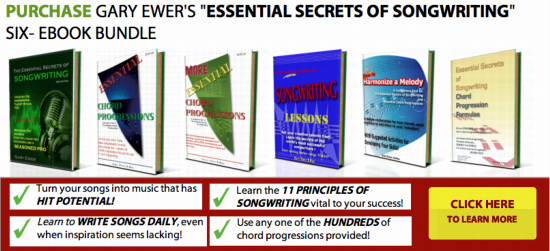Controlling song energy before you ever get to the studio gives great results.
______________
Download “The Essential Secrets of Songwriting 6-eBook Bundle“, and develop your songwriting skills.
______________
 In almost every post I write, I make reference to “energy.” In many respects, most of the compositional principles you apply to your songwriting come down to how you handle song energy.
In almost every post I write, I make reference to “energy.” In many respects, most of the compositional principles you apply to your songwriting come down to how you handle song energy.
The principle that refers specifically to this musical element is this: song energy at the end of a song should be the same as or greater than the energy at the beginning.
Even with songs that end quietly, you’ll find that the general movement of the energy was upward, with a sudden or gradually quiet ending. A good current example is Bruno Mars’ “When I Was Your Man“, but some classic examples would be Don McLean’s “American Pie“, Billy Joel’s “Piano Man“, and Amanda McBroom’s “The Rose“, made most famous by Bette Midler.
Sometimes controlling the energy of your song is something you think of doing when you’re in the production phase of your songwriting project. Playing and singing louder, higher, with fuller vocal harmonies — these are all typical ways we think of when we want to control how energetic a song is.
But before you even get to the studio, there are things you can do to subtly control energy. In fact, controlling energy at the songwriting stage has an advantage over production-level energy: energy that’s incorporated into a song as it’s written sounds natural, and has a subtlety that’s hard to duplicate in the studio.
Here are some thoughts to keep in mind as you compose your song:
- Work melodies upward as a song progresses. The higher a voice is required to sing, the more energy is naturally produced.
- Use a pre-chorus and/or bridge to boost energy smoothly and naturally. If you find that there’s too much of a jump in energy between verse and chorus, a jump that feels unnatural, a pre-chorus can help connect a verse and chorus in a natural way. A bridge after the 2nd chorus works well if you feel the need to build energy more than what the chorus was able to do.
- Use a lyrical progression to build energy. By lyrical progression we usually mean that the lyrics should either tell a story, or should describe people and events in a way that goes from simple observation to more emotive. That’s a natural process for lyrics when you move from verse to chorus, but you’ll also want to be sure that verse 2 has an intensity that surpasses verse 1, and so on.
_______________
Follow Gary on Twitter











Reblogged this on Bruno Mars.